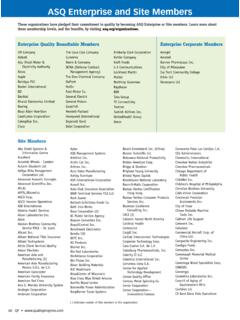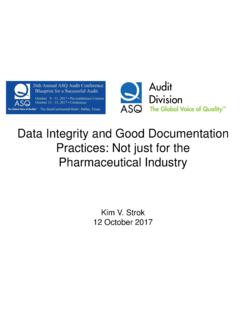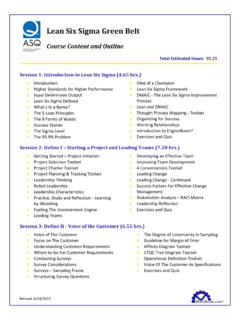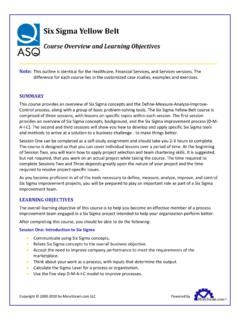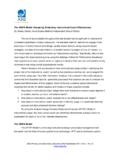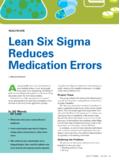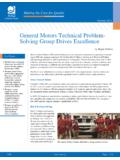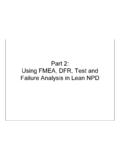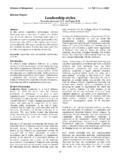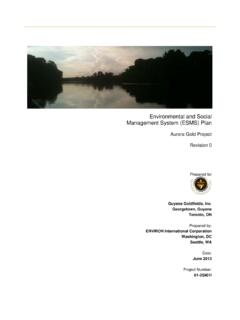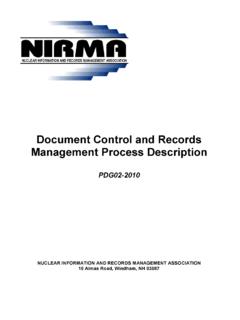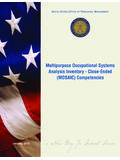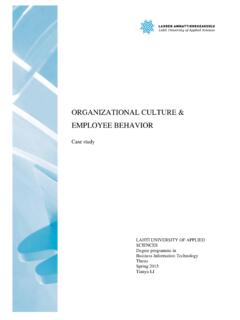Transcription of Auditing Process-based Quality Management Systems
1 Auditing Process-based Quality Management Systems Charlie Cianfrani and Jack West C. A. Cianfrani & J. E. West January, 2013. Agenda Course objectives What is an audit? How to prepare for and plan an audit How to conduct an audit How to report on an audit Course closing C. A. Cianfrani & J. E. West January, 2013. Course Objectives Learn the basics of performing internal audits of a QMS based on the process approach Process mentality Consider policy, objectives, processes, products and organizational alignment Prepare an audit plan Conduct an audit Document findings Write an audit report Ensure follow-up on corrective actions C. A. Cianfrani & J. E. West January, 2013. Agenda Course objectives Introductions What is an audit? How to prepare for and plan an audit How to conduct an audit How to report on an audit Course closing C. A. Cianfrani & J. E. West January, 2013. What is an audit? An audit* is a systematic, independent and documented process for obtaining audit evidence and evaluating it objectively to determine the extent to which audit criteria are fulfilled * Definition is from both ISO 9000:2005 Quality Management Systems - Fundamentals and vocabulary ISO 19011:2011 Guidelines for Quality and/or environmental Management Systems Auditing C.
2 A. Cianfrani & J. E. West January, 2013. What is an internal audit? An internal Quality audit is an audit that is performed by or at the direction of members of the organization C. A. Cianfrani & J. E. West January, 2013. Why audit? Possible reasons to audit: ensure compliance with ISO 9001:2008. ensure compliance with organization requirements ensure compliance with regulatory requirements ensure the QMS is effectively implemented and maintained C. A. Cianfrani & J. E. West January, 2013. Why audit? (continued). Auditing for improved performance look for opportunities for improvement look for best practices that could be applied in other areas look for preventive action look for outstanding emphasis on customer satisfaction C. A. Cianfrani & J. E. West January, 2013. Principles of Auditing Ethical conduct Fair presentation Professional care Independence Objectivity Impartiality Evaluations based on evidence Competence Cooperation Trust C.
3 A. Cianfrani & J. E. West January, 2013. Audit vs. Management Review vs. Self-assessment Three complementary concepts: What do we mean by self-assessment? - ISO 9004:2009 Annex A. - Baldrige What do we mean by Management review? They are all approaches to ensuring effectiveness, efficiency, improvement and customer satisfaction C. A. Cianfrani & J. E. West January, 2013. Three Types of Audits External independent audits third party Customer audits of suppliers second party Internal audits first party C. A. Cianfrani & J. E. West January, 2013. Three Types of Audits External independent audits third party Conformity to a specific standard REGISTRAR. STANDARD (9001) LIST. ORGANIZATION CUSTOMER. C. A. Cianfrani & J. E. West January, 2013. Three Types of Audits Customer audits of suppliers second party Conformance to customer requirements Customer's special interest items STANDARD ( ISO 9001). OTHER REQUIREMENTS. ORGANIZATION CUSTOMER.
4 C. A. Cianfrani & J. E. West January, 2013. Three Types of Audits Internal audits first party Performance to the organization's objectives Identification of problem areas! Finding opportunities for improvement! C. A. Cianfrani & J. E. West January, 2013. The Process Approach Evolving nature of Quality Management Internal focus vs. customer focus Control vs. improvement QA by QA vs. QA by organization Leadership: from QA or from Management Documented procedures vs. manage processes Independence of QA vs. integration Alignment of business, policy and objectives C. A. Cianfrani & J. E. West January, 2013. Remember the Quality Management principles? Principle #4 Process Approach A desired result is achieved more efficiently when activities and related resources are managed as a process. Principle #5 System approach to Management Identifying, understanding, and managing interrelated processes as a system contributes to the organization's effectiveness and efficiency in achieving its objectives C.
5 A. Cianfrani & J. E. West January, 2013. Process A group of interrelated activities and related resources that transforms inputs into outputs Controls Activity Activity Activity Input Output Process Resources C. A. Cianfrani & J. E. West January, 2013. System: A Family of Well Managed Processes Driven by Top Management Continually Improving Effectiveness C. Process Process U. Focused S. on T. O. Process Process Process M. E. R. Network of Interrelated Processes C. A. Cianfrani & J. E. West January, 2013. The SIPOC Model of a Process Inputs Inputs Outputs Outputs Suppliers Suppliers Process Process Customers Customers Requirements Requirements & &. Feedback Feedback The SIPOC model (suppliers, inputs, processes, outputs, customers). shows linkage of: processes from suppliers to final customers feedback from customers to the organization feedback from the organization to suppliers (see pg 16 in audit book). C. A. Cianfrani & J.
6 E. West January, 2013. ISO 9001 and Auditing Audits are covered in clause of ISO. 9001:2008 which is part of section 8 . Measurement, analysis and improvement . Emphasizes determining effective implementation and maintenance of the Quality Management system Note: the overall effectiveness of the Quality Management system is the responsibility of top Management C. A. Cianfrani & J. E. West January, 2013. Agenda Introductions Course objectives What is an audit? How to prepare for and plan audits How to conduct an audit How to report on an audit Course closing C. A. Cianfrani & J. E. West January, 2013. Planning the Audit Program C. A. Cianfrani & J. E. West January, 2013. The Audit Process An Overview Management Provide resources Review results Use results Input Internal Internal auditaudit Output Audit Report Policy Findings/CARs History Information Resources Follow-up Documents Time Improvement Customer Trained Conclusions feedback personnel Planning C.
7 A. Cianfrani & J. E. West January, 2013. Audit Conclusions Audit output conclusions may include: Conclusion regarding the conformance of the audited process to ISO requirements Statements regarding the suitability of a process to achieve objectives Comments regarding the effective implementation of a process Suggestions for consideration regarding possibilities for improvement C. A. Cianfrani & J. E. West January, 2013. Administrative Issues to Address Typically an audit boss is assigned by Management to oversee the internal audit process Clear charter for the internal audit process Tie with other Auditing ( , finance, EMS). Overall audit plan/schedule? How is input provided to Management review? Analysis of audit process and results? C. A. Cianfrani & J. E. West January, 2013. Auditor Criteria Need knowledge and skills in Audit principles, procedures and techniques Management system including Quality Management organizational understanding Specific process and product knowledge Social interaction Consider guidance in ISO 19011.
8 Education and experience Competence C. A. Cianfrani & J. E. West January, 2013. Lead Auditor Criteria Audit team leaders need to be able to: Plan audits Effectively communicate with auditees Organize and direct audit team members Lead team in reaching conclusions Prevent and resolve conflicts Coach auditors-in-training . Consolidate team inputs and prepare great reports C. A. Cianfrani & J. E. West January, 2013. Making an Audit Schedule List main activities (processes). List departments involved with the QMS. Decide what activities to audit in what departments Be sure to include Quality -relevant supporting activities Be sure to include ISO system-level activities Check to ensure coverage of all pertinent activities Assign individuals or teams to perform audits C. A. Cianfrani & J. E. West January, 2013. Audit Process Overview Prepare Perform Report the for the the audit results audit Perform corrective action C. A. Cianfrani & J.
9 E. West January, 2013. The Audit Process - Overview Prepare detailed plans for each audit Execute each audit Report audit results including conclusions and recommendations Corrective actions if needed Follow-up to ensure corrective actions are effective C. A. Cianfrani & J. E. West January, 2013. Audit Approaches Horizontal audit audit of one system across several functional groups (one thing-many places). audit across several groups to evaluate if a consistent approach is being followed for competence (Clause ). Vertical audit audit each function (department) of the organization and audit all processes in each function (many things-one place). audit within a manufacturing cell for process performance, product compliance, data analysis, corrective action, improvement etc., etc., Clauses , , , etc. Some combination of all of the above QA performs QMS audits (horizontal) and trained not full time auditors perform function audits (vertical).
10 C. A. Cianfrani & J. E. West January, 2013. Planning Individual Audits C. A. Cianfrani & J. E. West January, 2013. Prepare for an Audit Define audit objectives Define audit scope Typically done by audit boss Define audit resources Define audit criteria Prepare and distribute an audit notification to auditee Gather and understand relevant documents Prepare work plan audit plan C. A. Cianfrani & J. E. West January, 2013. Audit Objectives Compliance and improved effectiveness? (Required by ISO 9001!). Improved efficiency? (Perhaps needed for survival!). Both? C. A. Cianfrani & J. E. West January, 2013. Audit Scope What are the boundaries of an audit? What processes will we audit? What organizational functions are included? What is the audit emphasis? What is the timeframe? C. A. Cianfrani & J. E. West January, 2013. Audit Resources Who will audit? A team? An individual? If a team, who will be the lead auditor? Do we have appropriate personnel ( do we need any special technical expertise?)

